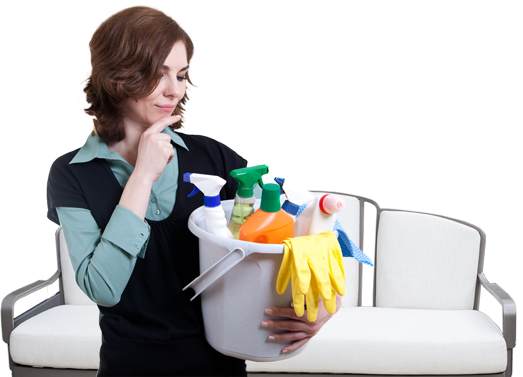The Truth About Using Steam Cleaners on Leather Furniture
Posted on 27/08/2025
The Truth About Using Steam Cleaners on Leather Furniture
If you're a proud owner of elegant leather furniture, you know how challenging it can be to keep it clean and looking its best. The allure of leather couches and sectionals is undeniable, but so is the fear of damaging them. There's a lot of advice floating around about deep cleaning methods, and a common debate is whether it's safe to use a steam cleaner on leather furniture. In this comprehensive guide, we'll uncover the truth about steam cleaning leather furniture, separating myths from facts so you can make informed decisions about maintaining your expensive furnishings.

Understanding Leather and Its Needs
Before delving into the effectiveness--or risks--of using a steam cleaner on leather chairs or sofas, it's vital to know what makes leather unique. Leather is a natural material, usually derived from animal hides, and is known for its durability, comfort, and timeless style. However, leather is also porous and, therefore, prone to absorbing liquids. Overexposure to moisture or heat can lead to:
- Cracking or drying out
- Color fading
- Warping or stretching
- Loss of suppleness
Thus, any cleaning method chosen must preserve these characteristics and not lead to unintended damage.
What is Steam Cleaning?
Steam cleaning is a popular eco-friendly cleaning method that uses high-temperature steam to loosen dirt, sanitize surfaces, and eliminate bacteria, dust mites, and stains. While it's excellent for many household surfaces, including tiles, grout, and fabrics, using steam cleaners on leather sofa or recliners is contentious for good reason.
How Do Steam Cleaners Work?
A steam cleaner heats water to over 200?F (93?C), emitting vapor through a nozzle. The hot steam lifts grime and sanitizes by killing germs. The process is quick, chemical-free, and highly effective--on the right surface.
Common Myths About Steam Cleaning Leather
- Myth 1: Steam cleaning is always safe for leather furniture.
- Fact: Direct steam and high heat can strip leather of its natural oils, causing irreparable drying, cracking, or warping.
- Myth 2: Steam cleaners clean leather deeper than any other method.
- Fact: Steam may remove surface dirt but can actually push moisture deep into the pores, potentially leading to mold, mildew, or even color distortion.
- Myth 3: Professional leather cleaners use steam.
- Fact: Most experts avoid steam cleaning leather furniture. They typically use specialized cleaning and conditioning agents designed specifically for leather's unique composition.
Can You Safely Use Steam Cleaners on Leather Furniture?
In most cases, direct steam cleaning is not recommended for leather furniture. Leather furniture is sensitive to heat and moisture--both of which are delivered by a steam cleaner in abundance. Here's why you should think twice before using a steam cleaner on leather recliner or sofa:
- Moisture Damage: Steam introduces water vapor at high temperatures. Prolonged exposure can cause the leather to become overly saturated, lose its supple texture, and even develop stains or mildew inside the pores.
- Heat Damage: The intense heat may cause leather fibers to contract or warp, resulting in cracks or a stiff, uncomfortable surface.
- Removes Natural Oils: Steam cleaning strips away the oils that keep leather soft and flexible. This can lead to brittle, crumbly leather, and a loss of sheen.
- Color Distortion: High temperatures and rapid moisture can affect dyes in leather, resulting in faded spots or uneven coloration.
In summary, while steam cleaning is a powerhouse for sanitizing and deep-cleaning many materials, using a steam cleaner on leather furniture brings considerable risk with little benefit.
Safe Alternatives for Cleaning Leather Furniture
Instead of risking damage with a steam cleaner, consider the following expert-recommended methods for keeping your leather couch or chair looking perfect:
1. Regular Dusting and Vacuuming
- Use a soft, dry microfiber cloth to remove surface dust and debris.
- Vacuum using a brush attachment to reach crevices--be gentle to avoid scratches.
2. Gentle Leather Cleaners
- Employ a commercially available cleaner specifically designed for leather.
- Always spot test first: Apply on a hidden area, wait 24 hours, and check for color changes or adverse reactions.
- Avoid products with harsh chemicals, ammonia, or bleach.
3. Conditioning
- About every 6-12 months, apply a quality leather conditioner to replenish natural oils and maintain suppleness.
- Use a soft, clean cloth to apply and gently buff in circular motions.
4. Promptly Treat Spills
- Blot immediately with a dry cloth. Do not rub, as this may spread stains.
- For sticky messes, use a slightly damp cloth (not wet!) and leather-friendly cleaning solution.
5. Professional Cleaning
- If your leather sofa has stubborn stains or significant soiling, hire a professional who specializes in leather care.
- Ask about their methods to ensure no steam cleaning is involved.
When (If Ever) Is Steam Cleaning Acceptable on Leather?
There are very limited scenarios where a steam cleaner for leather might be appropriate--mainly in the hands of a trained professional and using the lowest settings. For example:
- Quick Surface Passes: Some professionals use specific steam attachments that emit ultra-low moisture for a fraction of a second, followed by immediate drying. The risk is still present, but expertise and proper equipment can minimize damage.
- Faux Leather or Vinyl: Artificial leather furniture is less sensitive to heat and moisture, so gentle steam cleaning (after verifying manufacturer guidelines) may be less risky.
However, The risks typically outweigh the benefits when it comes to real leather. Most manufacturers of genuine leather sofas explicitly warn against any steam cleaning due to warranty voidance and damage concerns. Always check the care label and manufacturer guidelines before attempting any method.
Frequently Asked Questions (FAQ)
Q: Can I use a home steam cleaner for spot-cleaning minor stains on leather?
No. Even with spot cleaning, steam can cause leather to swell, discolor, or lose its finish. Spot-treat with a leather-specific cleaner instead.
Q: What should I do if I accidentally steam-cleaned my leather couch?
Immediately and gently blot any remaining moisture with a dry, clean towel. Keep the area ventilated and allow it to air dry--never use heat to dry leather. Next, apply a leather conditioner. If stains or stiffness occur, consult a leather care professional.
Q: Are there any steam cleaners made specifically for leather?
There are handheld steamers with fabric-safe attachments, but even these are not recommended for genuine leather furniture. They are better suited for delicate upholstery not made from animal hide.
Q: Can mild steam freshen up leather furniture without cleaning it?
It's risky. Introducing steam in hopes of merely 'refreshing' leather carries the same risks of moisture and heat damage, with very little cleaning benefit. Instead, air out your room and maintain your furniture with proper care and cleaning.
Expert Opinions on Steam Cleaning Leather Furniture
Multiple upholstery professionals and leather manufacturers have publicly stated their opposition to using steam on leather furniture. Some key points from expert sources include:
- Leather Doctor: Overexposure to moisture causes mold and weakens the hide's structure.
- Furniture manufacturers: Many void warranties if improper cleaning techniques such as steaming are used.
- Certified cleaning technicians: Statements universally resonate: "Steam cleaning is for fabric, not for leather."
*Always reference your leather furniture's care manual. If in doubt, contact the manufacturer or a cleaning pro specializing in leather.*
How to Restore Leather Furniture After Incorrect Cleaning
If you or a previous cleaner have already used a steam cleaner for leather sofa and are now witnessing dryness, hardening, or color issues, don't despair. Restoration is sometimes possible:
- Use a reputable leather conditioner: Thoroughly nourish the leather to restore lost oils and flexibility.
- Professional re-coloring: If fading or uneven color has occurred, a specialist can often re-dye or finish the leather to restore its appearance.
- Structural repairs: For cracks or warping, consult a leather repair expert for patching or re-bonding solutions.
Tip: The sooner you act after damage, the better the result.

Best Practices for Maintaining Leather Furniture
Keep your leather furniture looking luxurious with these time-tested tips:
- Keep leather away from direct sunlight: UV rays accelerate fading and drying.
- Maintain a moderate indoor humidity level: Too dry or too humid can harm leather.
- Apply leather conditioner regularly: Every 6-12 months is ideal, or as recommended by the manufacturer.
- Wipe spills immediately: Don't let liquids sit on the surface.
- Rotate seat cushions: For even wear and aging.
Conclusion: Should You Use Steam Cleaners on Leather?
The verdict is clear: Do not use steam cleaners on leather furniture. While steamers excel on many surfaces, leather is not one of them due to its porous, heat-sensitive, and oil-dependent nature. To preserve your investment:
- Choose gentle, leather-appropriate cleaning techniques.
- Condition your furniture routinely.
- Leave deep or difficult stains to leather-cleaning experts.
Remember, the truth about using steam cleaners on leather furniture is simple--what seems like an easy fix could end up costing you dearly. Treat your leather sofa or recliner with respect, patience, and the right care!
Further Reading
- The American Cleaning Institute
- Institute of Inspection Cleaning and Restoration Certification (IICRC)
- The Leather Repair Company
Take care of your leather, and it will take care of you for years to come!





